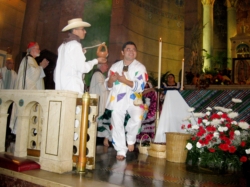From Cardinal Seán’s blog
From Monday through Wednesday I attended the U.S. Bishops’ meeting in Baltimore.
At the meeting we approved the pastoral letter ‘‘Marriage: Love and Life in the Divine Plan.’’
It was part of the Marriage Initiative that the USCCB has been working on for several years now.
Indeed, one of the five priorities that was set for the bishops’ conference was marriage and the family. I think this letter will be an important foundational document that will be quite helpful to us going forward.
Marriage is the centerpiece of God’s plan for humanity, so it is crucial for human society as well as for the Church. As we know, marriage is constantly under attack. The divorce mentality, cohabitation, and now the redefinition of marriage have been three very strong blows against the institution of marriage. In light of that reality, this pastoral letter is particularly important. I am pleased it was approved and we will work very hard to promote it in the Archdiocese of Boston.
As the chairman of the Clergy, Consecrated Life, and Vocations Committee I introduced Brother Paul Bednarczyk, CSC, the executive director of the National Religious Vocation Conference. Along with the Center for Applied Research in the Apostolate (CARA), they recently sponsored a study on religious life.
The study stressed the fact that, although most religious institutions in the United States are experiencing diminishing numbers, there are still young people who are coming to religious life. Seventy-eight percent of the men’s communities and 66 percent of the women’s communities have at least one candidate in initial formation.
They gave some further information about the characteristics of these new members:
-- The average age for entrance is 30.
-- 21 percent of those in initial formation are Hispanic, 14 percent are Asian, and 6 percent are African-American. (This is quite a change from the past.)
-- 9 in 10 were raised as Catholic (Meaning, of course, that 10 percent of them were received into the Church as adults.)
-- Almost 75 percent of them attended a Catholic school. (This, I think, underlies the importance of Catholic education for the formation of leaders in our Church.)
-- More than two-thirds of them had considered religious life by the time they were 21.
The most successful institutes, in terms of attracting and retaining new members are those that follow a more traditional style of religious life where the members live together in community, participate in daily Eucharist, pray the divine office, and engage in devotional practices together. Communities whose members wear a religious habit, work together in a common apostolate, and are explicit about their fidelity to the Church and the teachings of the Magisterium are the most successful communities -- both men’s and women’s -- in recruiting young candidates.
The best practices that Brother Paul and the study tried to promote were to instill a culture of vocations and to involve the membership and leadership in a concerted vocations promotion effort. They also underscored the importance of having a full-time vocation director, and talked about the importance of using the media, especially the internet. They also talked about the importance of discernment programs and opportunities for potential candidates to meet members of the religious community.
It was a very positive and hope-filled report on religious life at a time when the religious communities in the United States are being visited. I think it’s a hopeful sign that the Church is very concerned about promoting religious life. I was very happy to make that presentation to the Bishops Conference.



















